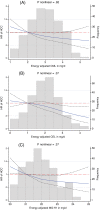Dietary intake of advanced glycation endproducts and risk of hepatobiliary cancers: A multinational cohort study
- PMID: 33899229
- PMCID: PMC8360042
- DOI: 10.1002/ijc.33612
Dietary intake of advanced glycation endproducts and risk of hepatobiliary cancers: A multinational cohort study
Abstract
Advanced glycation endproducts (AGEs) may contribute to liver carcinogenesis because of their proinflammatory and prooxidative properties. Diet is a major source of AGEs, but there is sparse human evidence on the role of AGEs intake in liver cancer etiology. We examined the association between dietary AGEs and the risk of hepatobiliary cancers in the European Prospective Investigation into Cancer and Nutrition prospective cohort (n = 450 111). Dietary intake of three AGEs, Nε -[carboxymethyl]lysine (CML), Nε -[1-carboxyethyl]lysine (CEL) and Nδ -[5-hydro-5-methyl-4-imidazolon-2-yl]-ornithine (MG-H1), was estimated using country-specific dietary questionnaires linked to an AGEs database. Cause-specific hazard ratios (HR) and their 95% confidence intervals (CI) for associations between dietary AGEs and risk of hepatocellular carcinoma (HCC), gallbladder and biliary tract cancers were estimated using multivariable Cox proportional hazard regression. After a median follow-up time of 14.9 years, 255 cases of HCC, 100 cases of gallbladder cancer and 173 biliary tract cancers were ascertained. Higher intakes of dietary AGEs were inversely associated with the risk of HCC (per 1 SD increment, HR-CML = 0.87, 95% CI: 0.76-0.99, HR-CEL = 0.84, 95% CI: 0.74-0.96 and HR-MH-G1 = 0.84, 95% CI: 0.74-0.97). In contrast, positive associations were observed with risk of gallbladder cancer (per 1 SD, HR-CML = 1.28, 95% CI: 1.05-1.56, HR-CEL = 1.17; 95% CI: 0.96-1.40, HR-MH-G1 = 1.27, 95% CI: 1.06-1.54). No associations were observed for cancers of the intra and extrahepatic bile ducts. Our findings suggest that higher intakes of dietary AGEs are inversely associated with the risk of HCC and positively associated with the risk of gallbladder cancer.
Keywords: EPIC study; advanced glycation endproducts; bile duct cancers; gallbladder cancer; hepatocellular carcinoma.
© 2021 The Authors. International Journal of Cancer published by John Wiley & Sons Ltd on behalf of UICC.
Conflict of interest statement
None of the authors declared a conflict of interest. Where authors are identified as personnel of the International Agency for Research on Cancer/WHO, the authors alone are responsible for the views expressed in this article and they do not necessarily represent the decisions, policy or views of the International Agency for Research on Cancer/WHO.
Figures

Similar articles
-
Dietary intake of advanced glycation endproducts is associated with higher levels of advanced glycation endproducts in plasma and urine: The CODAM study.Clin Nutr. 2018 Jun;37(3):919-925. doi: 10.1016/j.clnu.2017.03.019. Epub 2017 Mar 23. Clin Nutr. 2018. PMID: 29381139
-
Dietary intake of advanced glycation end products (AGEs) and changes in body weight in European adults.Eur J Nutr. 2020 Oct;59(7):2893-2904. doi: 10.1007/s00394-019-02129-8. Epub 2019 Nov 7. Eur J Nutr. 2020. PMID: 31701336
-
Dietary glycation compounds - implications for human health.Crit Rev Toxicol. 2024 Sep;54(8):485-617. doi: 10.1080/10408444.2024.2362985. Epub 2024 Aug 16. Crit Rev Toxicol. 2024. PMID: 39150724
-
Dietary Advanced Glycation End-Products and Colorectal Cancer Risk in the European Prospective Investigation into Cancer and Nutrition (EPIC) Study.Nutrients. 2021 Sep 8;13(9):3132. doi: 10.3390/nu13093132. Nutrients. 2021. PMID: 34579010 Free PMC article.
-
Smoking, Alcohol, and Biliary Tract Cancer Risk: A Pooling Project of 26 Prospective Studies.J Natl Cancer Inst. 2019 Dec 1;111(12):1263-1278. doi: 10.1093/jnci/djz103. J Natl Cancer Inst. 2019. PMID: 31127946 Free PMC article. Review.
Cited by
-
Dietary Intake of Advanced Glycation End Products (AGEs) and Mortality among Individuals with Colorectal Cancer.Nutrients. 2021 Dec 10;13(12):4435. doi: 10.3390/nu13124435. Nutrients. 2021. PMID: 34959986 Free PMC article.
-
Association of Dietary Advanced Glycation End Products with Overall and Site-Specific Cancer Risk and Mortality: A Systematic Review and Meta-Analysis.Nutrients. 2025 May 10;17(10):1638. doi: 10.3390/nu17101638. Nutrients. 2025. PMID: 40431378 Free PMC article. Review.
-
A 4-week high-AGE diet does not impair glucose metabolism and vascular function in obese individuals.JCI Insight. 2022 Mar 22;7(6):e156950. doi: 10.1172/jci.insight.156950. JCI Insight. 2022. PMID: 35133989 Free PMC article. Clinical Trial.
-
Receptor of advanced glycation end-products axis and gallbladder cancer: A forgotten connection that we should reconsider.World J Gastroenterol. 2022 Oct 21;28(39):5679-5690. doi: 10.3748/wjg.v28.i39.5679. World J Gastroenterol. 2022. PMID: 36338887 Free PMC article. Review.
-
A 4-Week Diet Low or High in Advanced Glycation Endproducts Has Limited Impact on Gut Microbial Composition in Abdominally Obese Individuals: The deAGEing Trial.Int J Mol Sci. 2022 May 10;23(10):5328. doi: 10.3390/ijms23105328. Int J Mol Sci. 2022. PMID: 35628138 Free PMC article. Clinical Trial.
References
-
- International Agency for Research on Cancer . GLOBOCAN 2018. Estimated age‐standardized incidence rates (world) in 2018, worldwide, both sexes, all ages, vol. 2019. Lyon, France; 2019.
-
- Bray F, Ferlay J, Soerjomataram I, Siegel RL, Torre LA, Jemal A. Global cancer statistics 2018: GLOBOCAN estimates of incidence and mortality worldwide for 36 cancers in 185 countries. CA Cancer J Clin. 2018;68:394‐424. - PubMed
-
- Center MM, Jemal A. International trends in liver cancer incidence rates. Cancer Epidemiol Biomarkers Prev. 2011;20:2362‐2368. - PubMed
Grants and funding
LinkOut - more resources
Full Text Sources
Other Literature Sources

